Risk Management in Software Development: 7 Common Risks
01.25.2022Like any other project, risk management in software development, if left unmitigated, can derail the project or even lead to catastrophic failure.
Whether you are a big corporate office, government agency, international organization, or a small startup, you should be actively engaged in risk management in software development.
Risk management for software development is critical. Even though we can’t foresee everything, we can prepare adequately to manage risks.
Common software project risks include budget overruns, delays in project implementation, personnel issues, poor productivity, low-quality products, etc.
As a project manager, being aware of potential software project risks, assessing them, prioritizing them, and having an action plan to manage them is essential.
This guide outlines the seven common sources of software development risks we see in different types of software development and how to deal with them effectively.
What is Risk Management in Software Development?
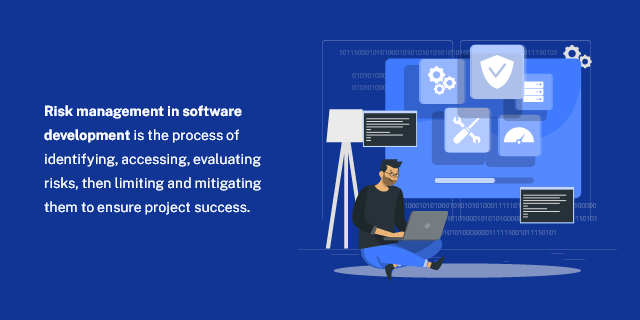
Risk management in software development is the process of identifying, accessing, defining response strategy, monitoring, and finally, responding according to your strategy - either accepting, transferring, mitigating or avoiding them to ensure project success.
Any threat, explicit or implicit, small or big, internal or external that threatens the successful rollout of your product should be carefully analyzed and mitigated or avoided.
Everybody involved in the project is responsible for identifying these threats and communicating them to the project manager for further processing.
Risk management in software development involves the following tasks:
- Identify
-
Recognize potential threats, including advanced data risk management in software engineering and global risk management.
-
Define a risk as it relates to software project management and assess its significance.
- Classify and prioritize
-
Categorize risks, applying risk management in software project management.
-
Prioritize identified software project risks to focus on those with the highest impact.
- Develop an action plan
-
Create an action plan template for risk mitigation, leveraging mitigation software.
-
Address specific applications of risk management in software project management, tailoring strategies accordingly.
- Continuously monitoring
-
Implement continuous monitoring in software lifecycle management risk
-
Foster constant communication within the team to identify and address new threats.
- Implement action plans
-
Act upon the action plan if any identified threat materializes.
-
Manage product development risks proactively using effective software risk assessment.
Importance of Risk Management in Software Development
Software development projects are complex undertakings often involving a big team and a huge budget.
However, the relentless pursuit of software development opportunities without the adequate software risk management are more likely to fail. Some project managers see risk management in software development and its attendant tasks as extra work and expense that doesn’t advance the core product development process.
This mindset is wrong and can prove to be costly to the project.
Adequate risk management in software development can:
-
Save money by cutting expenses associated with responding to unmitigated emergencies
-
Allow the development team to work faster by focusing on the core project, knowing that all risks are covered
-
Allow for a more accurate project estimate cost, without the risk of overrun costs due to unidentified risks
-
Build the reputation of the company/agency by ensuring that software development projects go as planned
Simply put, we cannot overstate the importance of risk management in software development.
Types of Risks in Software Development and How to Deal with Them
Effective risk management in software development demands a strategic approach to handle various challenges. Here, we delve into various types of software development risks and explore their applications in risk management.
1. Inaccurate Estimation Risks
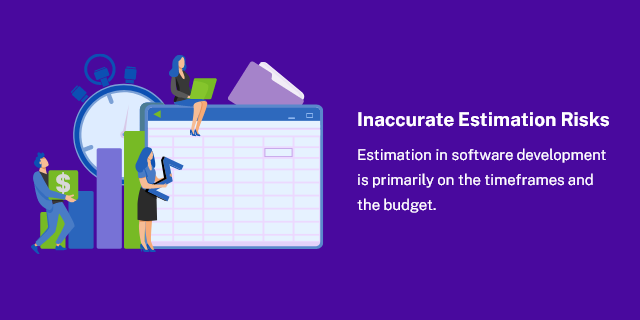
It is a critical part of risk management in software development. We are constantly making estimates, but there are risks related to creating expectations that are not realistic.
Estimation in software development is primarily related to timeframes and budget.
In terms of the time, the examples of IT risk management in software engineering are mainly related to underestimating the time frames required for different iterations.
As a project manager or decision-maker, you should resist the temptation to pressure the development team to deliver on unrealistic timelines. The quality risk management of doing this is not worth it. You run the risk of getting a low-quality iteration.
Similar to time, accurate budget estimation is crucial. Unrealistic budget expectations can jeopardize the project’s overall success. You need to communicate effectively with stakeholders about potential delays and conduct software risk assessments using advanced data software risk management techniques.
However, you also need to manage the customers and their expectations regarding delivering the software releases. Customers can be notoriously impatient, but they too should avoid their impatience materializing into a risk.
2. Scope Variation Risks
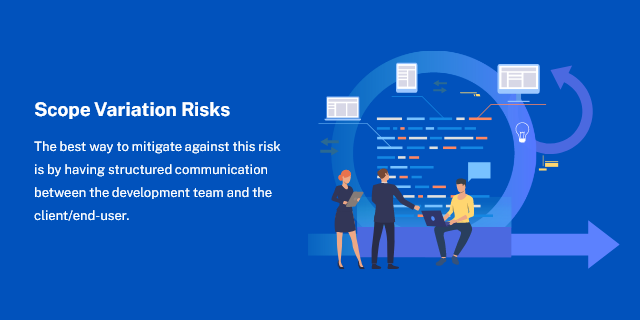
Among the biggest challenges that software developers face is scope variation. Changing requirements due to ongoing client and user feedback is a constant source of risks in software development.
It is a good thing on hand as it ensures that the final product is of sound quality and is helpful to the end-users.
However, from a risk management in software development perspective, it can lead to delaying project implementation, introducing numerous uncertainties or even lead to budget overruns and risks related to it.
The best practice is monitoring scope variations using a scope variation metric visible to both the development team and the customer.
The variation metric will serve as a tool to show how the scope variations have impacted the project in terms of budget and timelines. More importantly, it will help in prioritizing tasks.
However, for legacy systems, managing the scope can be challenging, as the existing software is often complex, interconnected, and highly customized. The scope of legacy systems must be clearly defined to ensure that the project is manageable and to avoid unnecessary costs and risks.
3. End-user Engagement Risks
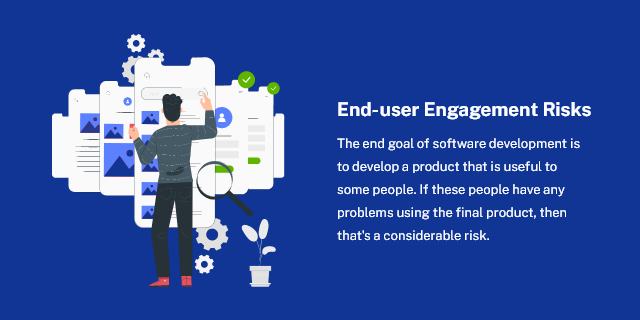
You cannot talk about risk management in software development without addressing the risks involved with end-user engagement.
The end goal of software development is to develop a product that is useful to some people. If these people have any problems using the final product, then that’s a considerable risk.
End-user engagement is critical to the project’s success, whether the software is for external customers or internal.
Strong end-user involvement and engagement throughout the project life cycle ensure the final product is easily acceptable.
You can achieve engagement through:
1. User surveys
Regularly conduct software risk analysis and management through user surveys throughout the project life cycle to gather valuable feedback directly from end-users. This feedback can uncover issues, preferences, and areas for improvement.
2. Frequent releases
Implement software risk assessment and strategy of frequent releases, allowing users to experience and provide feedback on incremental changes. This agile approach ensures that adjustments can be made promptly based on user input.
3. UX audits
Perform software risk analysis and management by conducting User Experience (UX) audits to evaluate the overall usability and design of the software. Identifying and addressing potential user interface issues can enhance the overall user experience.
4. Minimum Viable Product (MVP) release
Introduce MVP releases to gather early feedback on core features. This iterative approach helps in refining the product based on actual user usage patterns.
5. Beta testing
Engage users in beta testing phases to identify potential issues in a controlled environment before the full release. Beta testers can provide valuable insights into real-world usage scenarios.
Effective risk management in software engineering necessitates a keen focus on end-user engagement. By prioritizing user satisfaction, implementing feedback mechanisms, and leveraging application risk management, project teams can mitigate risks and ensure the successful adoption of the final product.
4. Stakeholder Expectations Risks
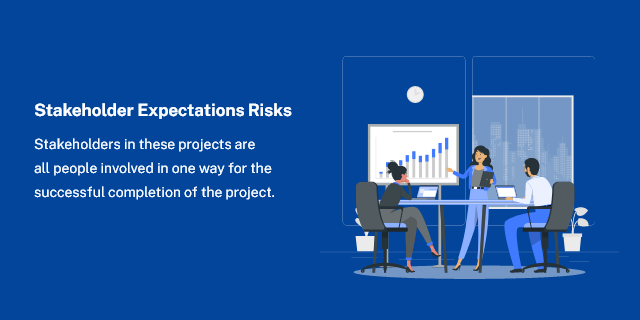
There are always stakeholder expectation risks in every software development project. Stakeholders in software development are all people involved in one way for the successful completion of the project.
Although, if there’s no management of expectation or frequent communication between project team and stakeholders in software development, there may be an introduction of risks that will be extremely difficult to mitigate, not even speaking about avoiding.
These risks may be related not only to project timeline and budget, but also to poor quality builds, incorrect functionalities, a misunderstanding of product goals, misdirected marketing strategies, and more.
Active and continuous involvement of stakeholders in software development throughout the project life cycle is a cornerstone of success. By understanding stakeholder needs, preferences, and potential risks, development teams can tailor the software to meet or exceed expectations.
5. Wrong Technical Decisions
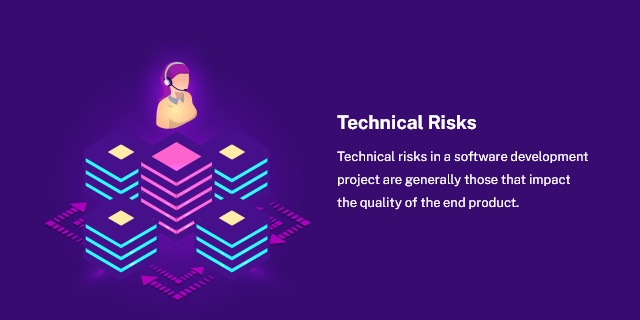
Technical risk management in a software development project is generally those that impact the quality of the end product. These are things like poor code, support, integration issues, unscalable architecture, etc. These technical risks can have a severe negative consequence on the usability of the product. That’s why it’s necessary to address technical risks when talking about risk management in software development.
The thing with technical risk management in software development is that these risks are not quickly noticeable during the development phase, but become apparent at the end of the software risk management process, which can make them challenging to correct. These risks are another reason to develop a proper application risk management strategy that supports the prediction of potential risks that may appear out of technical decisions.
There are also risks related to a long-term deadline that is still far into the future, and there is enough time to cover for any tasks not done.
Intense oversight of software iterations reduces technical risks.
Agile methodologies are particularly robust solutions in risk management for software as it encourages maintaining productivity and motivation among the development team.
6. Human Resource
While working with people, someone may unexpectedly become unavailable. This person may be a vital member of the team, which has the chance of creating a variety of risks, starting from a simple knowledge gap to ending with an extended timeline and overspent budget.
The person may be from the development team or the client-side, actively involved in the project.
It is critical for your team to maintain proper documentation of every detail of the project. Software development documentation is an active and continuous process.
Additionally, having contingency plans on how to onboard new team members should always be in place.
7. Communication Risks
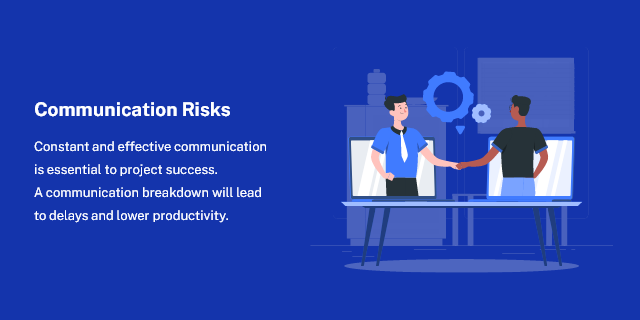
Just like in any other project, a breakdown in communication during software development is disastrous. Effective team risk management strategies are essential in ensuring project success, and one critical aspect to consider is the potential for communication breakdown. A breakdown in communication within the development team can lead to delays and lower productivity
The whole team should be committed to the project to mitigate and avoid a communication breakdown. When we talk about the team here, we mean everybody from the project manager, developers, testers, customers, etc.
Regular meetings of all stakeholders are an excellent way to keep everyone engaged and communication flowing. The purpose of the meetings should be to appraise each other of the progress and expectations.
Common Risk Management in Software Development Strategies
Having discussed the seven most common risk sources in software development, let’s now look at some practical strategies for responding to potential risks.
There are four main software risk assessment strategies, and you must carefully validate and assess each risk separately to choose the best strategy based on risk impact and consequences, as well as its probability.
1. Risk Avoidance
The best thing you can do with a risk is to completely avoid it from happening.
Some risks can be easily avoided, some will require a detailed plan and preparations for avoidance, especially when the impact of the risk may be catastrophic to a project - you must do everything to avoid it.
A team of dedicated software development professionals should be able to spot high risk areas of a project and move around them accordingly.
2. Risk Mitigation
If you cannot avoid a risk, you must define a plan to minimize its impact and its probability. Very often risk mitigation may be your plan B in case you fail to avoid a risk and it occurs.
You must try to define as many probable scenarios as possible to be best prepared. You also must define risk thresholds, in other words - to which extent you may allow a risk to occur or for how long you will monitor the risk until you decide that it’s time to act.
3. Risk Acceptance
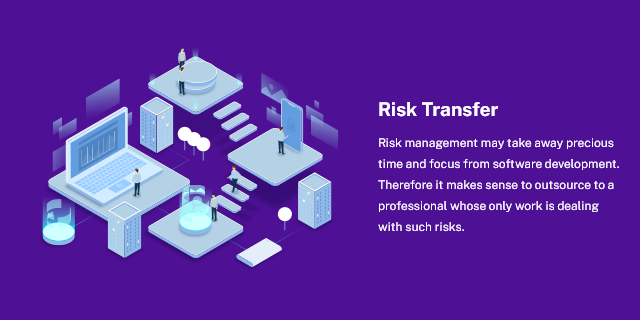
It doesn’t sound like a good strategy, but in the world of risk management for software, some risks are not worth mitigating or avoiding.If a risk has low impact and a high probability of happening, or could be costly to mitigate, accepting it may be the best option.
Small organizations/businesses or startups would benefit from this approach as mitigating certain software project risks would completely utilize their project’s budget.
4. Risk Transfer
To define the right risk response strategy, the first thing you need to ask yourself is whether the risk you are evaluating is and can be brought under the control of you and your team.
Very often there are risks related to someone else’s responsiveness, availability, and ability to provide materials and details to the team in a timely manner.
If this is out of your control, the best thing you can do is to transfer a risk to other parties, clearly communicating to them that this is their and only their responsibility, and if they do not do their part, you will have no leverage to avoid or even mitigate a risk.
Closing Thoughts
The ultimate objective of risk management in software development is to identify, track and mitigate all risks that could otherwise prevent successful implementation.
Agencies/corporates/startups should have a risk management framework for all their software development projects to achieve their goals.
The process of risk management in software development is continuous and applies throughout the life cycle of the project. Organizations with a robust risk management framework that guides all their software projects are more successful than those that don’t. That’s why it’s important to know how to select the right software development consultancy.
How Can DOOR3 Help?
Partnering with DOOR3 can help you develop a concrete threat model for your web or mobile software project based on current software development trends. With industry expertise gained from various projects, companies better understand appropriate risk management strategies based on the project type and goals.
With our legacy application modernization services, we can help organizations effectively manage the scope of their modernization projects and minimize the risks associated. Contact us today for risk management services in software development.



